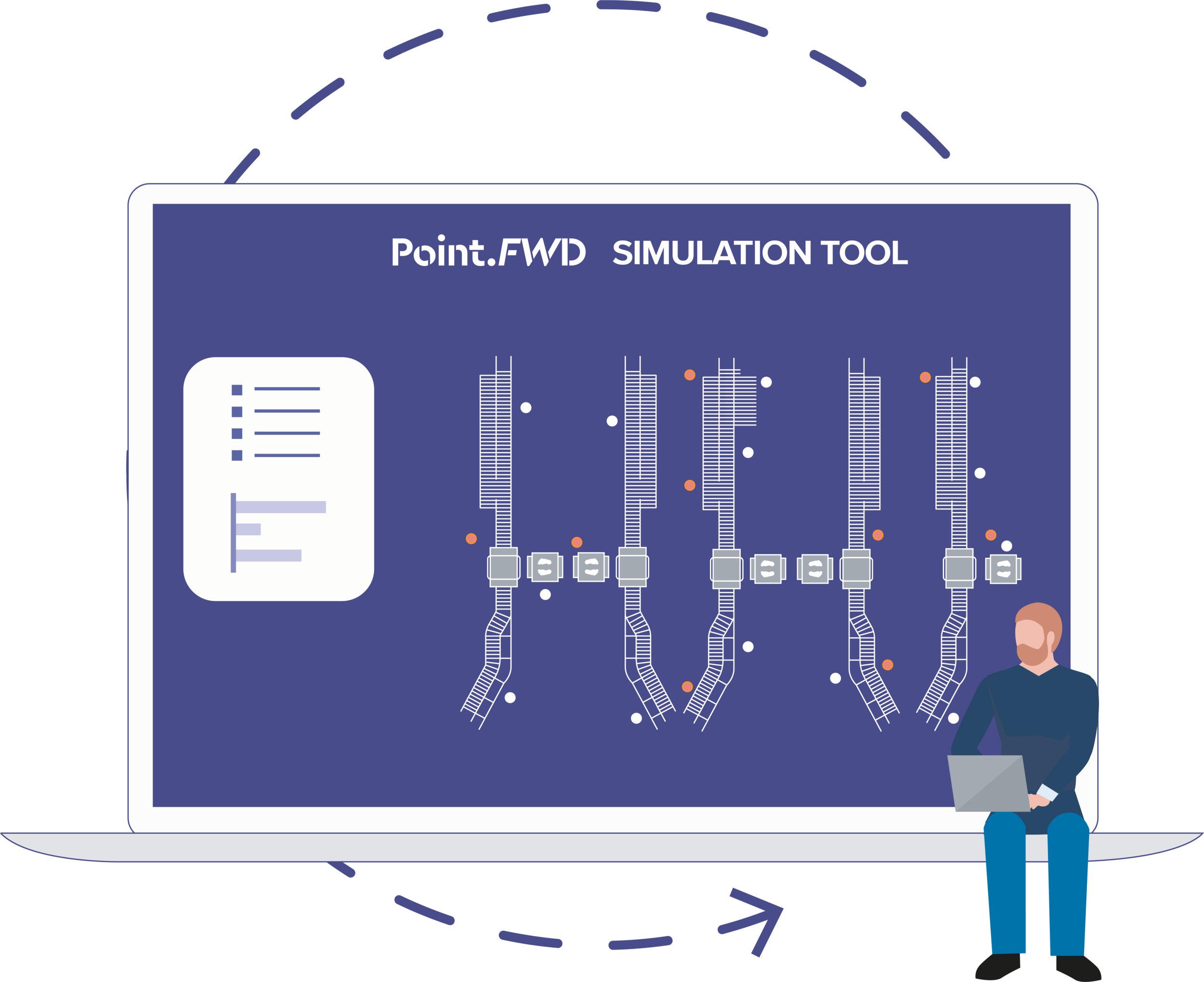Every security checkpoint is under constant pressure of changing situations. These can be triggered by a change in spacing due to construction plans, as well as policy changes looking at new procedures for screening passengers, or potentially an upgrade in screening technologies. Point FWD sees the security checkpoint as a coherent system of technologies, processes and people in which balance is the key to success at every unique location. Our challenge in this puzzle is to transition from a rather uncertain situation – i.e. getting surprised by external changes that impact checkpoint operations – to a situation where airports, airport operators and suppliers are in good shape for any upcoming change.
In this blog we like to give a short introduction about 3D simulations in security checkpoints by which digital representations of security operations can act as a “Sand-Box” to experiment with planned, or even unplanned changes. We believe that for a majority of changes to the security checkpoint, costly trial projects and time efforts could be reduced by building a digital model of the operational situation, but only when there is a sufficient level of operational detail.
Specifically we take a look at three main application areas in where simulations show great benefits, being:
Checkpoint redesign and technology upgrades;
Checkpoint resilience testing; and
Security process optimisation.
1. Checkpoint redesign and technology upgrades
A first area of application in which simulations can provide great benefit - and certainly all aviation professionals are most familiar with – is in design and planning projects. For example terminal expansion programs or security checkpoint redesign projects, which are often combined with technology upgrades such as ATRS, CT scanners or Security Scanners. However, most design simulations delivered for projects like mentioned mainly focus on generic passenger flows, which are modelled based on rather generic dynamics about security checkpoints. This is done by looking at acceptable security input and output values providing a good sense of passenger flows and queue areas.
Point FWD’s view in these projects is that for gaining the most accurate representation of a future checkpoint situation, more detail such as process anomalies, operational variations and airport specifics are required to understand different design scenarios for security checkpoints. Discrete event simulations can provide a visual representation of the detailed process and can provide further insight on how and where passengers precisely accumulate in the process itself and how a design could be altered to potentially resolve this. It also provides a dynamic component to the process by showing how lane and checkpoint throughputs are constantly varying over time and during peak hours. Below a simulation example based on the transition from x-ray to CT scanners and the impact thereof on process performance is included.
Design use case: Moving from standard X-ray to CT scanners. This video shows an example of the level of detail by which CT implementations can be tested, validated and successfully prepared by means of accurate simulations.
2. Checkpoint resilience testing
As of recent years, more and more airports adopt digital strategies to manage challenges that relate to operational stability. These include platforms for accurately forecasting actual passenger demand, based on real-time flight schedules and passenger data, increasingly with use of AI engines to detect anomalies. For the purpose of flexibly, both up- and down-scaling resources and assets during operational hours - especially capacity intensive terminal processes such as check-in, baggage reclaim and security - can benefit.
In case of the security checkpoint situation, on a different level than these real-time monitoring and planning systems, resilience levels can be tested, validated and improved greatly by a simulated environment. By doing so, exploring what-if scenarios in terms of common and uncommon events that happen in the checkpoint environment is possible, such as security lane errors or high threat procedures. Virtual representations of security lanes can then help in testing stress levels of checkpoint environments with regards to the number of lanes available for operation at maximum, versus passenger demand and key performance metrics. Eventually, a simulation of potential disruptions help in preparing for future threats to operation, and help to implement robust operational plans.
Resilience use case: Outage of a security lane during peak times. This video exemplifies an operational situation that focuses on testing and validating operational plans for checkpoint situations, really looking at the impact on capacity and passenger flow.
3. Security process optimisation
Ideally, security checkpoints should accommodate for an environment to securely and swiftly process significant numbers of actual passengers. Often, the operation is not running optimally and it is key to determine what is causing problems in the checkpoint so that these problems can be understood and solved.
Optimisation issues that can be assessed and fixed with simulations include, among other things, large queues with high queue times, low throughput, or the occurrence of bottlenecks. To recreate this operational situation in a digital twin environment, it is essential to have accurate and reliable input. This specific process data, such as processing times, reject rates and X-ray analysis times, are obtained both by extracting machine data, as well as manually collected measurements. Using this as input for the simulation, the process can be imitated and issues like mentioned can be tracked down. In doing so, experiments can be run which are testing different solution possibilities, such as changes in CONOPS or resources, delivering a better understanding of how this would effect, and potentially optimize the process, before ultimately implementing these changes in real-life operation.
Optimisation use case. In this video an example focused on the impact of the tray per passenger rate is simulated. It may help to simulate the operational impact of policy adjustments and CONOP changes in optimisation projects.
The importance of accurate input parameters
Simulation can be an excellent tool to create a virtual model of a security checkpoint. This environment can be manipulated and changed to either visualize the impact of certain changes or to see where bottlenecks are likely to occur. However, to create a digital twin of a specific security checkpoint, it is essential that the input parameters of the checkpoint represent the actuals. If the input is not correct, the output including the solutions to the initial issue, may not have the desired effect.
Data that is often required for complete simulations include screening system outputs, arrival patterns of passenger flows, but also more specific passenger data that often differentiates across airports. The latter is much often hard to capture with machine efforts, and therefore needs manual capturing. Point FWD’s Checkpoint Insight Tool is a tooling platform to help airport operators and OEMs to do just that.
Checkpoint Simulations by Point FWD
Has this blog made you curious or are you already contemplating about running a simulation for your business? At Point FWD, we are happy to help and answer in case specific questions about simulations in security checkpoints arise. We are open for demo requests and like to think with you in the solutions that can be brought with our security checkpoint simulation capability.




















